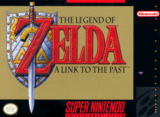This game can be given the impressive title of being one of Nintendo's greatest works. Utterly flawless.
The Bad: Well, nothing.
The Legend of Zelda for NES was one of the most popular games on the console, right up there with Super Mario Bros. itself. The biggest, most noticeable flaw was that the world was huge and no one knew where to go. While Nintendo fixed that issue with a map given out to gamers of the day, the game is rather difficult to navigate now.
The Adventure of Link, the follow-up on NES of 1988 wasn't exactly a bad game, but it just wasn't Zelda. It got rid of the unique qualities of the first and replaced them with tried and true ideas of the time.
A Link to the Past, however, changes everything back to the way it was, except better, in literally every way.
The story, while not really original to present day Zelda, was quite unique at the time. Much more of it was involved, and the characters had depth (despite being 32-bit sprites, still), As opposed to the simplistic work of the first two (collect items to save Zelda), this one delves deeper in that you have to collect the items to get new weaponry, such as the Master Sword, which are the only weapons capable of defeating your opponents. Plus, the backstory of Hyrule and the Triforce, the power of the goddesses left behind from the land's creation, is told at last, as well as how it was sealed away to protect it from evil. The six maidens you'll also be saving give you yet more insight into the land of Hyrule, which we barely got a glimpse of in the previous titles.
And Nintendo's masterful improvements didn't stop at the story. Naturally, the graphics were much more than a step up, and the music composer, Koji Kondo, kept the classic Hyrule Field Theme, which is actually a good thing, but made it sound less... digital, while simultaneously making the sound effects far better.
There are two rather similar worlds to explore, but it just adds to the sheer size of the game that makes it so enjoyable: the Light and Dark Worlds. While the transition between them is somewhat difficult, it gets easier as you go (and early on you don't even go to the Dark World), making it barely a trifle of an issue. Thanks to both worlds, which would be big on their own, the title hits at least fifteen to twenty hours of gameplay, with a whopping eleven levels and making the original Zelda's Hyrule look miniscule.
More to the point: you absolutely must play this game. All those who say Zelda is overrated don't have the right to say it until they play this. The controls are better in every way in this title than its predecessors, the graphics and sound are more crisp, clean, efficient, and straight up better, and you'll never, ever regret the $8 investment. I'd tell you more, but it would ruin what is quite possibly the best 2-D game ever made.

